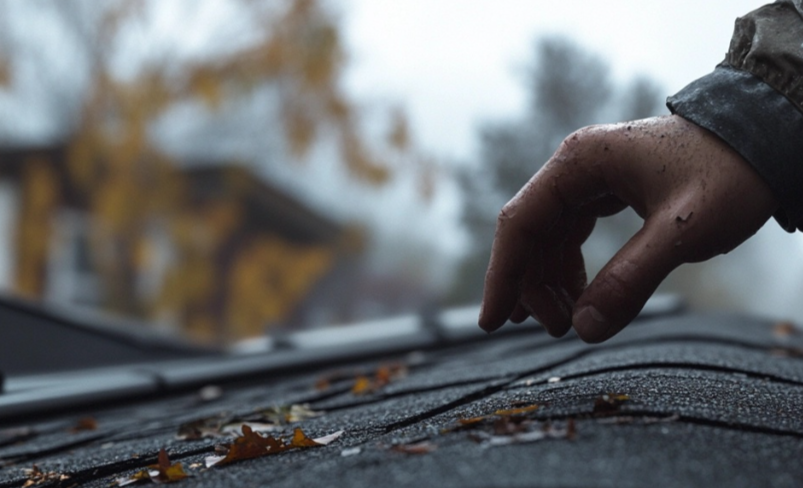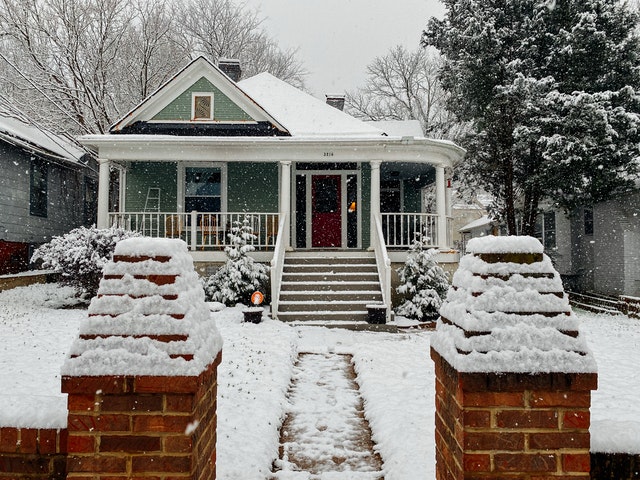
Your roof is the first line of defense against weather, so keeping it in good shape can save you from expensive repairs. Regular inspections let you catch minor issues—like small leaks or loose shingles—before they turn into costly problems.
For instance, a tiny crack in the flashing around a vent or chimney can let water seep in over time, damaging the roof’s underlayment and even leading to mold in your attic. Roof inspections also help identify age-related wear and tear, which can show up as curling shingles, granule loss, or sagging areas.
What You Can Check Yourself Between Professional Inspections
Between professional inspections, a quick DIY check can help keep your roof in good shape.
Start by walking around your home and looking up at the roof—check for any shingles that look out of place, cracked, curled, or even missing. Pay special attention to the flashing around chimneys, skylights, and vents, as small gaps or rust spots can allow water to seep in.
Inspect the gutters for signs of shingle granules; if you see a buildup, it may mean your shingles are deteriorating.
Inside, check your ceiling for water stains, especially in the attic, as these can signal a hidden leak. Staying vigilant with these checks can help you spot early signs of damage and prevent costly repairs down the line.
Common Problems Found in Routine Inspections
Regular roof inspections often uncover minor issues that can turn into costly repairs if ignored. Damaged or missing shingles, for instance, may seem minor, but they can lead to leaks and water damage inside the home, which is far more expensive to fix.
Signs of granule loss on shingles—visible as sand-like grit in your gutters—show that shingles are wearing down, indicating it’s time to replace them before leaks begin.
Inspectors also frequently find problems with flashing around chimneys and vents, which, when damaged, allows water to seep into the structure, causing hidden damage to the roof deck and framing.
The High Cost of Ignoring Minor Issues
The small issues discovered during inspections can feel easy to overlook, but they have a costly downside. A cracked shingle, for example, might cost a hundred bucks to repair, but if water infiltrates, it can lead to rot in the decking and interior damage that could require a full roof section replacement.
Similarly, rusty or loose flashing might seem minor, but when water penetrates the attic or wall space, it can lead to mold, damaged insulation, and even weakened structural beams. Repairing minor damage early is far more affordable than dealing with the aftermath.
How Seasonal Changes Affect Your Roof’s Health

Each season brings unique challenges that can impact your roof’s condition, making regular inspections especially valuable:
- Winter: Snow and ice buildup can lead to ice dams, which can push water under shingles and cause leaks.
- Spring: Heavy rains can expose weak spots in your roof, and any lingering winter damage could worsen with moisture.
- Summer: Heat and UV rays cause shingles to dry out and crack, especially on older roofs.
- Fall: Leaves and debris collect in gutters, leading to water buildup and potential leaks.
Scheduling inspections around these seasonal changes allow you to address these weather-specific issues before they turn into costly repairs.
When It’s Time to Bring in a Professional
Some roof issues aren’t easily visible and require a pro to catch before they worsen. Here’s when to make that call:
- Sagging or Uneven Spots: Sagging indicates structural weakness—often due to water damage, rotting wood, or excess weight—that can lead to serious structural repairs if ignored. A pro can assess the severity and recommend solutions.
- Heavy Granule Loss on Shingles: If you’re seeing excessive granules in gutters or around your property, it’s a sign shingles are deteriorating. A professional can evaluate whether it’s a simple fix or if a replacement is necessary.
- Cracked or Rusted Flashing: Flashing around vents, chimneys, and skylights is prone to wear. Damaged flashing often causes slow leaks that lead to hidden water damage. Professionals have the tools to seal these areas properly and prevent further leaks.
- Visible Mold, Rot, or Moisture Indoors: If you’re noticing mold or mildew smells, or if attic wood looks damp, it’s likely a sign of a leak. A roofing specialist can pinpoint the leak source and fix it, stopping further interior damage.
How Often Should You Inspect Your Roof?
Inspecting your roof at least twice a year—once in spring and once in fall—helps catch seasonal damage early, whether it’s the freeze and thaw cycle of winter or the intense summer heat.
These inspections are especially crucial because each season brings unique wear that, if unnoticed, can lead to costly repairs down the line. Additionally, it’s smart to check your roof after any severe weather events, like hailstorms or high winds, as these can displace shingles, damage flashing, or even cause hidden leaks. If you notice signs of wear such as loose shingles, water stains inside your home, or clogged gutters, consider inspecting sooner or calling a professional. A consistent inspection routine like this keeps your roof in good shape and helps prevent unexpected expenses.
The Payoff: How Routine Inspections Save You Money
Routine inspections do more than just catch minor issues—they also help you understand both latent and patent defects in your roof. Latent defects in real estate specifically (there are many kinds) are hidden problems that might only become visible over time, like gradual water damage under shingles, while patent defects are more obvious issues like missing or broken shingles that anyone can spot.
Routine roof inspections aren’t just about keeping things looking good—they’re about saving money, reducing stress, and preserving your home’s integrity.





